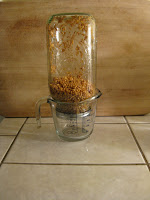
if you're at all interested in learning how to ferment foods the book i mentioned earlier wild fermentation by sandor ellix katz is a great place to start. number one because it's probably the best comprehensive guide to fermenting everything from kraut to yogurt to wine. number two because sandor, or "sandorkraut" as he likes to be known, is a fiery force of social change and fermentation ideas. i love him! his website is wild fermentation. here's a quote from his book that gets me all fired up:
"social change is another form of fermentation. ideas ferment, as they spread and mutate and inspire movements for change. the oxford english dictionary offers as the second definition of ferment: 'the state of being excited by emotion or passion, agitation, excitement...a state of agitation tending to bring about a purer, more wholesome, or more stable condition of things.' the word 'ferment' derives from the latin fervere, 'to boil.' 'fervor' and 'fervent' are other words from the same root. fermenting liquids bubble just like boiling liquids. excited people can channel the same intensity, and use it to create change.
[...]
your life and my life and everyone's lives and deaths are part of the endless biological cycle of life and death and fermentation. wild fermentation is going on everywhere, always. embrace it. work with the material resources and life processes that are close at hand. as microorganisms work their transformative magic and you witness the miracles of fermentation, envision yourself as an agent for change, creating agitation, releasing bubbles of transformation into the social order. use your fermented goodies to nourish your family and friends and allies. the life-affirming power of these basic foods contrasts sharply with the lifeless, industrially processed foods that fill supermarket shelves. draw inspiration from the action of bacteria and yeast, and make your life a transformative process. "
yay for weirdos like sandor! and i mean weirdo in the best possible way.





















